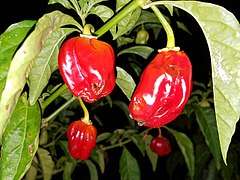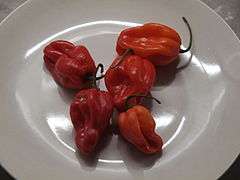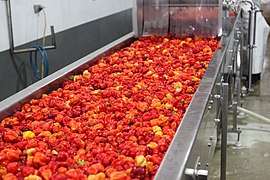Habanero
The habanero (/ˌ(h)ɑːbəˈnɛəroʊ/; Spanish: [aβaˈneɾo] (![]()
| Habanero | |
|---|---|
 | |
| Species | Capsicum chinense |
| Cultivar | 'Habanero' |
| Heat | |
| Scoville scale | 100,000–350,000 SHU |
Name
The name indicates something or someone from La Habana (Havana). In English, it is sometimes incorrectly spelled habañero and pronounced /ˌ(h)ɑːbəˈnjɛəroʊ/, the tilde being added as a hyperforeignism patterned after jalapeño.[3]
Origin and use
The habanero chili comes from the Amazon, from which it was spread, reaching Mexico.[4] A specimen of a domesticated habanero plant, dated at 8,500 years old, was found at an archaeological site in Peru. An intact fruit of a small domesticated habanero, found in pre-ceramic levels in Guitarrero Cave in the Peruvian highlands, was dated to 6500 BC.
The Habanero is named after the Cuban city of La Habana, known in the U.S. as Havana, because it used to feature in heavy trading there. It is related to the Scotch bonnet pepper; they have somewhat different pod types but are varieties of the same species and have similar heat levels.
Today, the largest producer of the Habanero pepper is the Yucatán Peninsula, in Mexico where it is now thought to have originated.[5] Habaneros are an integral part of Yucatecan food, accompanying most dishes, either in natural form or purée or salsa.[6] Other modern producers include Belize, Panama, Costa Rica, Colombia, Ecuador, and parts of the United States, including Texas, Idaho, and California.
The habanero chili was disseminated by Spanish colonists to other areas of the world, to the point that 18th-century taxonomists mistook China for its place of origin and called it Capsicum chinense ("the Chinese pepper").[7][8][9]
The Scotch bonnet is often compared to the habanero, since they are two varieties of the same species, but they have different pod types.[6] Both the Scotch bonnet and the habanero have thin, waxy flesh. They have a similar heat level and flavor. Both varieties average around the same level of pungency, but the actual degree varies greatly from one fruit to another according to genetics, growing methods, climate, and plant stress.
In 1999, the habanero was listed by Guinness World Records as the world's hottest chili, but it has since been displaced by other peppers. The Bhut jolokia (or ghost pepper) and Trinidad moruga scorpion have since been identified as native Capsicum chinense subspecies even hotter than the habanero. Breeders constantly crossbreed subspecies to attempt to create cultivars that will break the record on the Scoville scale. One example is the Carolina Reaper, a cross between a Bhut jolokia pepper with a particularly pungent red habanero.
Cultivation
Habaneros thrive in hot weather. Like all peppers, the habanero does well in an area with good morning sun and in soil with a pH level around 5 to 6 (slightly acidic). Habaneros which are watered daily produce more vegetative growth but the same number of fruit, with lower concentrations of capsaicin, as compared to plants which are watered only when dry (every seven days).[10] Overly moist soil and roots will produce bitter-tasting peppers. Daily watering during flowering and early setting of fruit helps prevent flower and immature fruit from dropping, but flower dropping rates often reach 90% even in ideal conditions.[10]
The habanero is a perennial flowering plant, meaning that with proper care and growing conditions, it can produce flowers (and thus fruit) for many years. Habanero bushes are good candidates for a container garden. In temperate climates, though, it is treated as an annual, dying each winter and being replaced the next spring. In tropical and subtropical regions, the habanero, like other chiles, will produce year round. As long as conditions are favorable, the plant will set fruit continuously.
Cultivars
Several growers have attempted to selectively breed habanero plants to produce hotter, heavier, and larger peppers. Most habaneros rate between 200,000 and 300,000 on the Scoville scale. In 2004, researchers in Texas created a mild version of the habanero, but retained the traditional aroma and flavor. The milder version was obtained by crossing the Yucatán habanero pepper with a heatless habanero from Bolivia over several generations.[11] Breeder Michael Mazourek used a mutation discovered by the Chile Pepper Institute to create a heatless version labeled the 'Habanada' bred in 2007 and released in 2014.[12] [13]
Black habanero is an alternative name often used to describe the dark brown variety of habanero chilis (although they are slightly different, being slightly smaller and slightly more sphere-shaped). Some seeds have been found which are thought to be over 7,000 years old. The black habanero has an exotic and unusual taste, and is hotter than a regular habanero with a rating between 425,000 and 577,000 Scoville units.[14] Small slivers used in cooking can have a dramatic effect on the overall dish. Black habaneros take considerably longer to grow than other habanero chili varieties. In a dried form, they can be preserved for long periods of time, and can be reconstituted in water then added to sauce mixes. Previously known as habanero negro, or by their Nahuatl name, their name was translated into English by spice traders in the 19th century as "black habanero". The word "chocolate" was derived from the Nahuatl word, xocolātl [ʃoˈkolaːt͡ɬ], and was used in the description, as well (as "chocolate habanero"), but it proved to be unpronounceable to the British traders, so it was simply named "black habanero".[15]
A 'Caribbean Red,' a cultivar within the habanero family, has a citrusy and slightly smoky flavor, with a Scoville rating ranging from 300,000 to 445,000 Scoville units.[16]
Gallery
 Red Habanero Chilis growing on the plant
Red Habanero Chilis growing on the plant- Habanero seedling
 Habanero plant with fruit
Habanero plant with fruit.jpg) Habanero plant with fruit and flower
Habanero plant with fruit and flower- Orange habanero
 Orange habaneros
Orange habaneros Red habaneros
Red habaneros Red habaneros on a plate, bought from a food store
Red habaneros on a plate, bought from a food store Belizean red habaneros being prepared for washing, sorting and grinding
Belizean red habaneros being prepared for washing, sorting and grinding
See also
- Capsicum (pepper family)
- Jalapeño
- Scotch bonnet
- Race to grow the hottest pepper
References
- "Chili – Evergreen Organics". EvergreenOrganicsBelize.com. Retrieved 1 December 2016.
- "Chile Pepper Heat Scoville Scale". Homecooking.about.com. Retrieved 14 April 2013.
- "Habanero". Merriam-Webster. Retrieved 26 October 2013.
- "El chile habanero de Yucatán. Origen y dispersión prehispánica del chile habanero". Ciencia y Desarrollo. May 2006. Archived from the original on 12 February 2012. Retrieved 7 January 2015.
- "Profile of the Habanero Pepper". Whole Chile Pepper Magazine. July 1989. Archived from the original on 6 September 2012. Retrieved 14 April 2013.
- "Habanero". WorldCrops.org. Retrieved 24 March 2017.
- Bosland, P.W. (1996). J. Janick (ed.). "Capsicums: Innovative Uses of an Ancient Crop". Progress in New Crops. Arlington, Virginia: ASHS Press: 479–487. Retrieved 14 April 2013.
- Bosland, P.W. "The History of the Chile Pepper". Brooklyn Botanic Garden. Archived from the original on 24 May 2014. Retrieved 12 December 2014.
- Eshbaugh, W. Hardy (1993). "Peppers: History and Exploitation of a Serendipitous New Crop Discovery". In Janick, Jules; Simon, James E. (eds.). New Crops. New York: Wiley. p. 132–139. ISBN 9780471593744 – via purdue.edu.
- Ruiz-Lau, Nancy; Medina-Lara, Fátima; Minero-García, Yereni; Zamudio-Moreno, Enid; Guzmán-Antonio, Adolfo; Echevarría-Machado, Ileana; Martínez-Estévez, Manuel (1 March 2011). "Water Deficit Affects the Accumulation of Capsaicinoids in Fruits of Capsicum chinense Jacq". HortScience. pp. 487–492. Retrieved 17 August 2017.
- Santa Ana, Rod, III (12 August 2004). "Texas Plant Breeder Develops Mild Habanero Pepper". AgNews. Retrieved 18 March 2020.
- Page-Mann, Petra (6 April 2015). "Habanada: The Unmasked Habanero". Cornell Small Farms Program. Retrieved 9 March 2018.
- Danovich, Tove (12 February 2017). "This Heatless Habanero Packs All Of The Flavor With None Of The Burn". NPR.org. NPR. Retrieved 9 March 2018.
- "Chocolate Habanero: Smoky Sweet Heat".
- "Black Habanero". Archived from the original on 29 October 2013.
- "Caribbean Red Habanero: Tropical Thunder". PepperScale. 6 May 2016. Retrieved 2 July 2017.
External links
| Wikimedia Commons has media related to |
- Clarke, Dale C. (2003–2004). Aji Chombo peppers. Photographic account of chilies grown in Fairfax, Virginia, from seeds imported from Panama.